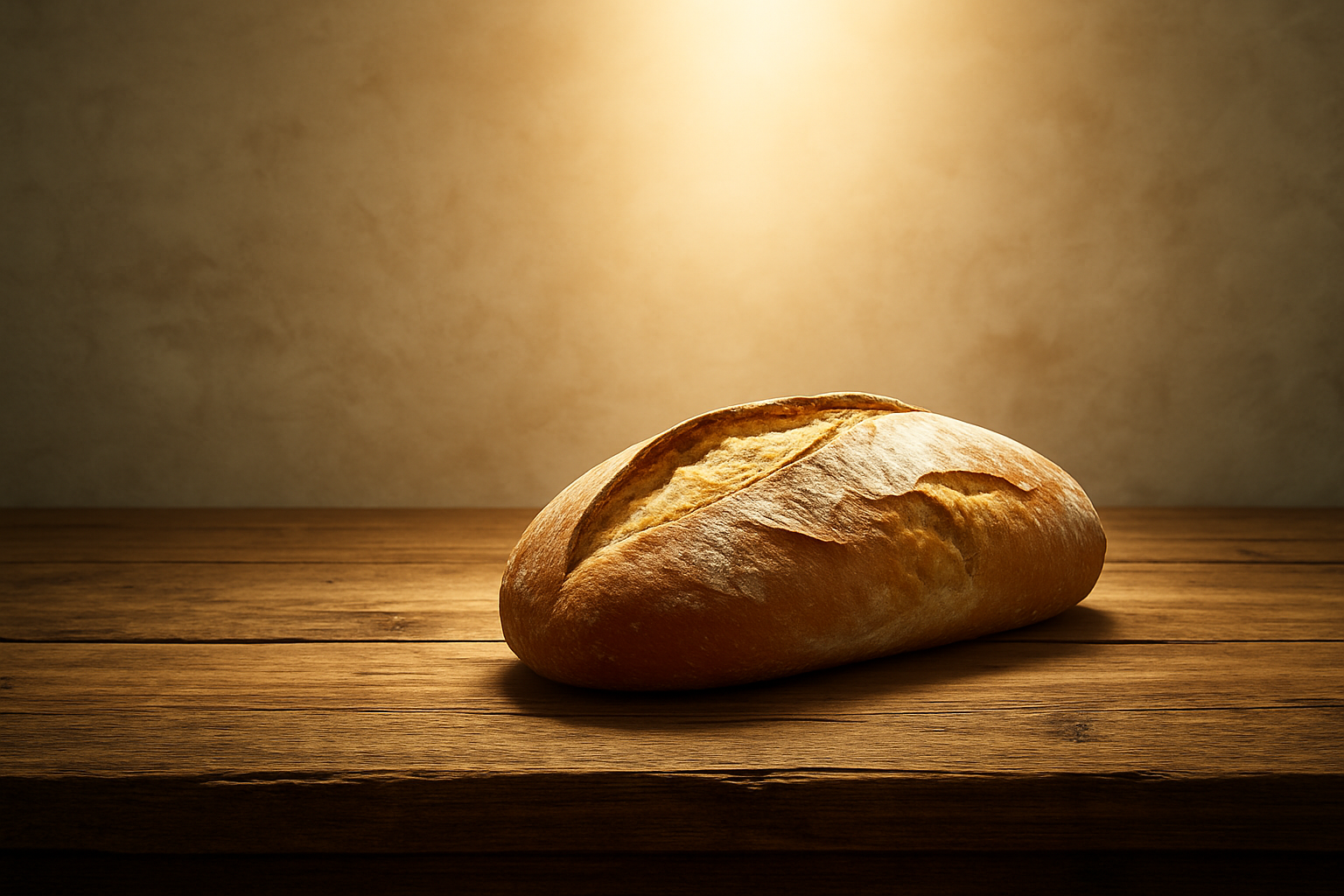Not By Bread Alone — The Power of Vision

The Gaze of Bitachon Turns Hashem’s Word Into Life
Scientists tell us that at the smallest scales of reality, particles don't take on a definite state until they're observed—until someone is actually looking. Observation doesn't merely reveal reality; it brings it into being. That's physics. Yet the Torah described this dynamic long ago albeit in very different language. In Parashat Eikev we read (Devarim 8:3): לֹא עַל־הַלֶּחֶם לְבַדּוֹ יִחְיֶה הָאָדָם כִּי עַל־כׇּל־מוֹצָא פִי־יְיָ יִחְיֶה הָאָדָם (Not by bread alone shall the man live, but by everything that proceeds from the mouth of Hashem shall the man live).
There's a tremendous paradox in this pasuk. If the mouth of Hashem is the true source of all life and sustenance, then why isn't life experienced as whole and complete? If the Divine word is constantly giving life to all creation, why do we feel hunger, longing, or even experience delays in receiving what we need—physically and spiritually? The pasuk seems clear: life is not from bread itself but from 'everything that proceeds from the mouth of Hashem,' i.e. from Divine speech. Bread exists, and Hashem's word is sustaining it—that much is clear. So what's missing? To put it another way, if the life-force is already there—because Hashem's speech is ongoing and unceasing—why does it often not 'land' in our lives as timely blessing or wholeness?
In a nutshell, the missing ingredient is sight. Let's explain.
R' Nachman of Breslov explains (Likutei Moharan 76:1): הִנֵּה, בְּהִסְתַּכְּלוּת יֵשׁ אוֹר הַיָּשָׁר וְאוֹר הַחוֹזֵר, דְּהִתְפַּשְּׁטוּת הָרְאוּת הוּא אוֹר הַיָּשָׁר וּבְהַגִּיעַ לִרְאוֹת דָּבָר שֶׁחָפֵץ הוּא אוֹר הַחוֹזֵר (Behold, in vision there is the direct light [ohr ha-yashar] and the returning light [ohr ha-chozeir]: the spreading forth of sight is the direct light, and when it reaches to see something that it desires, that is the returning light). R' Nachman is not explaining physics. He is explaining the spiritual mechanics behind vision. Nevertheless, his words do play out even in the physical realm. For example, let's say that someone wants to look at a celestial object. He must first turn his gaze toward the object of interest. In Kabbalistic terms, this is called ohr ha-yasher—the direct light. In modern terms, it's like aligning and focusing a telescope on a distant star. But that's not enough. There must be another ingredient—ohr ha-chozeir—the returning or reflected light that returns from the object to the observer. In the modern world, we understand this as the photons of light which enter the eye from the distant object. R' Nachman is saying that in order for there to be true vision or sight, one must have both components.
But it's more than that. Anticipating the advances of modern physics by approximately 120 years, R' Nachman writes something extraordinary (Likutei Moharan 76:2): וְדַע שֶׁהִסְתַּכְּלוּת עוֹשָׂה כְּלִי, דְּהַיְנוּ גְּבוּל וּזְמַן. כִּי מִקֹּדֶם רְאוֹתוֹ הַדָּבָר, הוּא בְּלֹא גְּבוּל, וּכְשֶׁרוֹאֶה הַדָּבָר, נַעֲשֶׂה לוֹ גְּבוּל (And know, that sight makes a vessel [k'li]—that is, dimension and time. For before one sees a thing, it has no dimension, and when he sees it, dimension is formed for it). If we understand גְּבוּל not merely as 'boundary' but as 'dimension' or 'space,' then we have a strikingly precise description of what modern physics has come to recognize—seeing doesn't reveal reality, it creates it. This is more than abstract theory; it affects how we experience even basic sustenance.
According to R' Nachman, this concept is what lies behind a rather strange statement in Devarim 8:16. Referring to Hashem, the pasuk says: הַמַּאֲכִלְךָ מָן בַּמִּדְבָּר אֲשֶׁר לֹא־יָדְעוּן אֲבֹתֶיךָ לְמַעַן עַנֹּתְךָ (Who fed you man in the desert, which your ancestors did not know, in order to afflict you). To afflict them? Didn't Hashem feed them the man because He wanted to be compassionate and kind? How are we to understand this statement? The Gemara in Yoma 74b provides us with a clue that is relevant to our discussion: אָמַר רַב יוֹסֵף: מִכָּאן רֶמֶז לְסוֹמִין שֶׁאוֹכְלִין וְאֵין שְׂבֵעִין (Rav Yosef said, From here [Devarim 8:16] there is an allusion [to the truth] that a blind person does not feel satiety when he eats). A blind person never feels satiety? This seems even stranger. What does all of this mean?
R' Nachman explains it based on what he already revealed—the act of seeing itself creates the k'li. And since a blind person cannot see the food he is eating, he is incapable of creating the k'li of true satiety. Yes, he is eating, and yes, he may even get 'full' in the biological sense, but he never actually creates the spiritual k'li of satiety. Although he may have eaten the bread, it is as if it never reached its intended place.
This leads us to the importance of bitachon—trusting in Hashem.
How is the k'li of bitachon actually created? It is created when we 'look' toward Hashem. Looking leads to trusting, as R' Nachman states explicitly: כִּי הַבִּטָּחוֹן הוּא בְּחִינַת הִסְתַּכְּלוּת (For bitachon is an aspect of looking). But this is not a chiddush of R' Nachman. It is exactly what David ha-Melech said (Tehillim 145:15): עֵינֵי־כֹל אֵלֶיךָ יְשַׂבֵּרוּ וְאַתָּה נוֹתֵן־לָהֶם אֶת־אׇכְלָם בְּעִתּוֹ (The eyes of all look to You with hopeful expectation, and You give them their food in its time). To connect David ha-Melech's words to the Gemara in Yoma 74b, R' Nachman explains: כִּי עַל־יְדֵי הַהִסְתַּכְּלוּת בְּבִטָּחוֹן גַּם כֵּן עוֹשֶׂה כְּלִי, דְּהַיְנוּ גְּבוּל וּזְמַן (For looking with bitachon also creates a k'li—namely, dimension and time). As he goes on to explain, the outpouring of Divine sustenance to the world—shefa—is unceasing. It's constant. There is never a moment when it doesn't flow from Heaven. That being the case, how come we don't seem to be able to 'catch' it at times?
This is what R' Nachman is revealing to us. The directed gaze toward Hashem makes the k'li for the Divine shefa so that it arrives, as the pasuk says explicitly—בְּעִתּוֹ, in its time—at the right time.
Think of Hashem's shefa as a Wi-Fi signal—ever-present and constantly streaming. But to receive it, we need a functioning device: a k'li. Vision provides the 'hardware,' but without the 'software' of bitachon, nothing runs. Only when the two come together does the k'li form, allowing the shefa to reach us not only in the right place, but at exactly the right time. Without either one, the signal still exists—but remains inaccessible.
We need not only to look, but to look with purpose—with focus and inner trust. R' Nachman teaches that bitachon is what activates the k'li. Bitachon is the software that, together with the hardware of vision, shapes the k'li and sets the timing so the shefa reaches us exactly where and when we need it. That's why David ha-Melech specifically placed the word בְּעִתּוֹ at the end of the pasuk. It's not just that 'the eyes of all look' to Hashem and He gives them sustenance. No—it's that their gaze of trust draws down the sustenance in its time. That's the key. That's what creates the true spiritual k'li.
R' Nachman even extends this idea beyond physical sustenance—teaching that the same vessel-making vision transforms our yearning in avodah, renews our consciousness each day, and even elevates a person in the face of great trials—but his central point remains: without the focused gaze, the shefa never reaches us in a way that truly helps us.
And this brings us back to our original pasuk (Devarim 8:3): לֹא עַל־הַלֶּחֶם לְבַדּוֹ יִחְיֶה הָאָדָם כִּי עַל־כׇּל־מוֹצָא פִי־יְיָ יִחְיֶה הָאָדָם (Not by bread alone shall the man live, but by everything that proceeds from the mouth of Hashem shall the man live). The pasuk is very clear in that the bread is not alive by itself, but rather that it is sustained by the Divine speech that gives it its essence. So what exactly is R' Nachman's chiddush? He is telling us that speech is linked to Divine vision—Hashem's 'looking' creates time and space and vitality for each thing to exist. R' Nachman, preceding physicists by 120 years, offers a metaphor for a reality that quantum physics would later affirm: until observed, reality doesn't fully 'collapse' from its potential state into an actualized state. In a sense, Hashem’s gaze gives the world its life. And when we turn our eyes to Him with trust, we make space for that life to reach us in a very personal and holy way.
And that's where our 'looking' comes in. Just as Hashem's looking creates the space and the time for everything, we have to mirror that. When we look with focus and purpose—not just at an object, but at Hashem—we become co-creators of the spacetime from which Divine light can emerge. And that's what actually gives life. That's what sustains us. That's the meaning of 'not by bread alone shall man live.' It's not the bread alone, nor even that which emanates from Hashem's mouth—although both are needed. R' Nachman adds that vision—both Hashem's and ours—is the critical component that creates timely sustenance, giving the shefa its proper place and time—בְּעִתּוֹ.
So what does man live on? He lives on the life-force, the vitality, that is embedded in each and every aspect of creation which reaches man and nourishes him through the k'li created by vision and bitachon.
And this is what quantum mechanics has come to see as well. Observation collapses potential into actuality—a state of existence that we can interact with and benefit from. Likewise, R' Nachman's Torah in Likutei Moharan 76 teaches us that bitachon collapses the unbounded shefa into lived and accessible blessing, giving it space as well as time. And what is astonishing is that R' Nachman anticipated this dynamic—that consciousness through the act of looking co-creates reality—more than a century ahead of the rest of humanity.
Life isn't from bread or even Divine speech alone—it's from our living relationship with Hashem, formed when we lift our eyes to Him in trust. Bitachon isn't passive; it creates the vessel that lets His life-giving word reach us—in its perfect time, transforming faith into lived experience.






